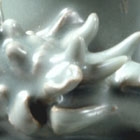J.J. Lally & Co., Oriental Art / New York City, New York
MenuPast Exhibition
Chinese Ceramics A.D. 400–1400:
Selections from an American Collection
March 19 - 31, 2007
19.
A LONGQUAN CELADON DRAGON JAR AND COVER (PANLONG PING)
Southern Song Dynasty, A.D. 12th-13th Century
of upright ovoid form with slightly tapering wide cylindrical neck, decorated with slender rising petals moulded in relief around the sides below three tiers of rounded collars applied with a four-claw dragon modelled in high relief with open jaws and protruding tongue under a pointed snout, shown coiled around the shoulders in vigorous pursuit of a beribboned ‘pearl’ and with a stylized flame motif applied at the side of the neck, covered inside and out with a lustrous blue-green glaze ending just above the neatly pared edge of the high ring foot, the interior of the recessed base also glazed, the lip and foot rims unglazed and the exposed stoneware burnt to pale reddish tan color in the firing, the shallow domed cover with flat flaring rim surmounted by a recumbent dog finial and glazed to match.
Height 10 1⁄4 inches (26 cm)
From the Collection of Lord Cunliffe
A Longquan celadon covered vase of similar form and design, with a dragon in high relief pursuing a beribboned ‘pearl’, is illustrated in Gugong Bowuyuan Cang Wenwu Zhenpin Quanji, Liang Song Ciqi II, Vol. 33 (The Complete Collection of Treasures of the Palace Museum, Beijing, Porcelain of the Song Dynasty, Book II), Hong Kong, 1996, no. 104, p. 116.
Another Longquan dragon jar of this type, with a flat cover, excavated at Longquan city and now in the Wenzhou Museum, is illustrated by Zhu, Longquan Yao Qingci (Celadons from Longquan Kilns), Taipei, 1998, no. 105, p. 138; and a Longquan dragon jar with domed cover surmounted by a recumbent dog finial in the Shanghai Museum is illustrated op. cit., no. 102, p. 135. Compare also the example from the Russell Collection illustrated by Gompertz, Chinese Celadon Wares, London, 1980, pl. 76, p. 154.
Another Longquan celadon dragon jar of this type is illustrated by Scott, Percival David Foundation of Chinese Art, A Guide to the Collection, London, 1989, no. 44, p. 57, together with a similar covered jar applied with a tiger around the shoulders. This type of celadon jar was made in pairs, one with a dragon and the other with a tiger, representing the East and West respectively, and they were placed in their appropriate directions in the tomb.
